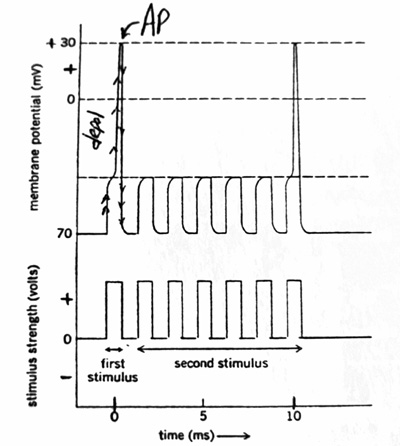Electrical Refractory (Recovery) Period following an Action Potential

Let’s use an analogy here. If a guy ejaculates, you gotta wait a little bit before he could do it again. How long does it take to recover from one orgasm before he could do it again? If he’s 16 years old, it might take 30 seconds. In a 90 year old it might take several months. This is called the refractory or recovery period between one orgasm to another. Some woman could experience multiple orgasms but that’s not really possible with guys. Muscle and nerve cells (excitable cells) need some time to recover before they do it again.
The electrical refractory (recovery) period (R.P.) is the period of time following an Action Potential when the cell will not respond to another stimulus.
 On the right, we have time going by on the x-axis in milliseconds. On the y-axis is the voltage on the membrane of the cells. We have the first stimulation of the cell and we see depolarization occur. We immediately stimulate it again and and what is generated is not an action potential. The definition of an AP is a reversal of its polarity. In this case the mV is going from -70 to -50 but it’s not positive. If you keep stimulating it, it will not make another action potential until the sixth time. This is suggesting that this cell needed some time to recover before doing another AP. That’s because the Na+/K+ ATP pump is working. How long does this refractory period take? Look at the graph. It’s about 10milliseconds. It’s not like half an hour or a couple days. It’s just at 10 milliseconds.
On the right, we have time going by on the x-axis in milliseconds. On the y-axis is the voltage on the membrane of the cells. We have the first stimulation of the cell and we see depolarization occur. We immediately stimulate it again and and what is generated is not an action potential. The definition of an AP is a reversal of its polarity. In this case the mV is going from -70 to -50 but it’s not positive. If you keep stimulating it, it will not make another action potential until the sixth time. This is suggesting that this cell needed some time to recover before doing another AP. That’s because the Na+/K+ ATP pump is working. How long does this refractory period take? Look at the graph. It’s about 10milliseconds. It’s not like half an hour or a couple days. It’s just at 10 milliseconds.
Why is the Refractory Period important to know?
The length of the cells electrical R.P. determines the maximum frequency of AP’s it can generate. In this nerve cell, it can generate about 1 AP every 10 milliseconds. Can we figure out how many AP’s that would be in a second?
1 AP / 10msec X 1000 msec / sec = 100 APs / sec
So there is a limit. You can’t fire off a 1,000 APs per second, you could only fire off 100.
Electrical Refractory Period of the Heart
Remember everything pertaining to nerve cells includes all muscle cells since they are excitable as well, including cardiac muscle. The non-pacemaker heart cells have a refractory period of 3/10ths of a second. So if one second is a thousand milliseconds, how many milliseconds is that refractory period? That’s 0.3 * 1000, so that’s 300 msec. Heart cells have recovery times of 300msec, which is much longer than what we just said about nerve cells having a 10msec RP.
Can we figure out the theoretical maximal heart rate?
We all know our heart rates max out when we exercise. It doesn’t just go as fast as possible. Your heart rate is limited to the refractory period of the cardiac cell. The electrical RP is 0.3 second and for each AP, that causes ONE beat of the heart. If you could calculate the maximum number of APs in a minute, you could calculate how fast the heart could beat.
What is the maximal heart rate in BPM? That would be 60s/0.3s = 200 beats per minute.
Now let’s learn all about threshold stimuli…






